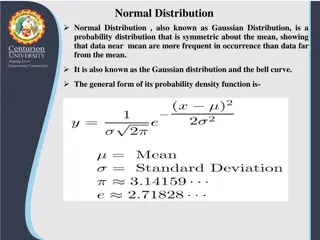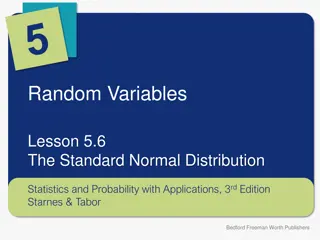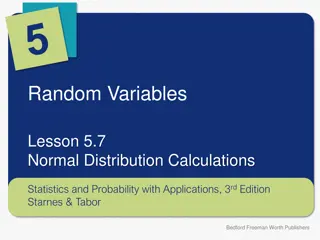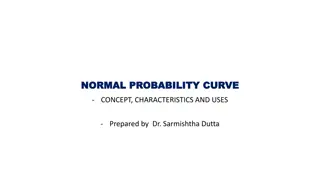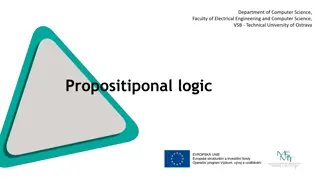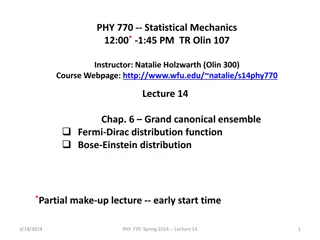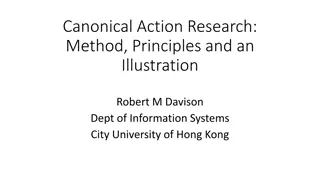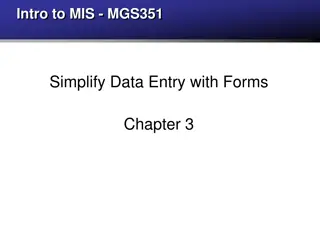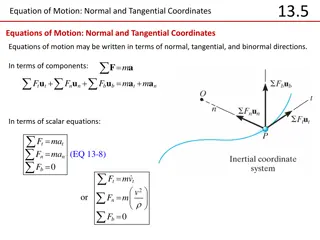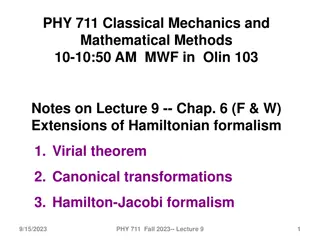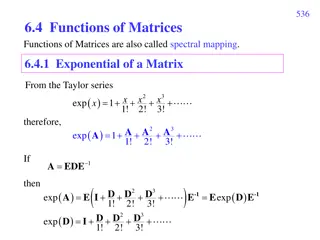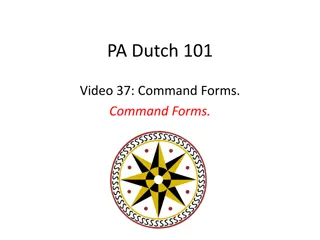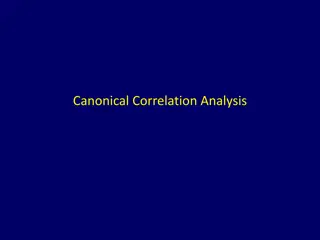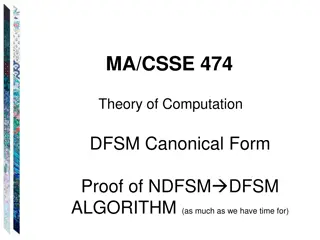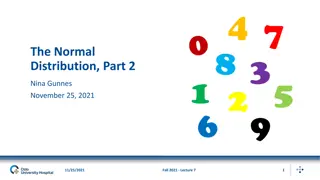Normal Distribution in Statistics Education
Lesson resources for teachers to teach students about analyzing and understanding normal distribution in statistics. Includes learning standards, agenda, presentation, vocabulary activities, and additional resources. Emphasizes using mean and standard deviation to fit data to a normal distribution,
10 views • 23 slides
Normal Conditions of Use for New Propulsion Technologies in Vehicles
Explore the concept of normal conditions of use for vehicles with new propulsion/charging technologies. Learn how to assess and define normal conditions, operating modes, worst case scenarios, and overview of current technologies. Discover the approach to measure normal conditions and testing requir
2 views • 8 slides
Normal Distribution and Its Business Applications
Normal distribution, also known as Gaussian distribution, is a symmetric probability distribution where data near the mean are more common. It is crucial in statistics as it fits various natural phenomena. This distribution is symmetric around the mean, with equal mean, median, and mode, and denser
3 views • 8 slides
The Standard Normal Distribution in Statistics
Exploring the significance of normal distributions in statistics, this lesson covers the 68-95-99.7 rule, using Table A to find probabilities and z-scores, properties of normal curves, and the standard normal distribution. Key concepts include the mean, standard deviation, and how to standardize var
5 views • 9 slides
Normal Distribution Calculations in Statistics
Exploring normal distribution calculations in Statistics involves calculating probabilities within intervals and finding values corresponding to given probabilities. This lesson delves into the application of normal distribution to determine probabilities of scoring below a certain level on tests an
3 views • 13 slides
Normal Distribution in Probability
Explore the properties and characteristics of the normal distribution, including the mode, symmetry, inflection points, and the standard normal distribution. Learn how to use standard normal tables to find probabilities and areas under the curve. Practice using examples to calculate probabilities ba
1 views • 35 slides
Managing Normal.dotm in Microsoft Word
Learn about Normal.dotm in Microsoft Word, the default template for new documents. Find out how to locate, create, modify, and deal with corrupted Normal.dotm files. Explore the importance of Normal.dotm in customizing your Word documents efficiently.
0 views • 19 slides
The Normal Probability Curve
The Normal Probability Curve, also known as the normal distribution, is a fundamental concept in statistics. It is symmetric around the mean, with key characteristics such as equal numbers of cases above and below the mean, and the mean, median, and mode coinciding. The curve's height decreases grad
1 views • 10 slides
Boolean Algebra: Canonical Normal Form, Minterms, and Maxterms Explained
Boolean algebra concepts including Canonical Normal Form, Minterms, and Maxterms are discussed in detail, along with examples and truth table representations. The Consensus Theorem and Redundant Theorem of Boolean Algebra are also explained, highlighting simplification techniques for Boolean express
0 views • 5 slides
Normal and Abnormal Behavior: Perspectives and Definitions
Normal behavior varies from person to person and society, influenced by individual preferences and societal norms. Abnormal behavior is characterized by an inability to function effectively or personal discomfort. The concept of normality and abnormality in psychology raises complex questions about
3 views • 8 slides
Normal Forms in Propositional Logic
Explore the concept of normal forms in propositional logic, where each formula has a unique truth-value function. Learn about equivalence of formulas, determining normal forms, and canonic forms like Disjunctive Normal Form (DNF) and Conjunctive Normal Form (CNF). Discover how to find canonic forms
2 views • 22 slides
Grand Canonical Ensemble in Statistical Mechanics: Fermi-Dirac Distribution
Exploring the Fermi-Dirac distribution function and the Bose-Einstein distribution in the context of the grand canonical ensemble for non-interacting quantum particles. The lecture delves into the impact of particle spin on energy spectra, enumeration of possible states, self-consistent determinatio
1 views • 33 slides
Canonical Action Research: Method, Principles, and Practice
Canonical Action Research involves researcher intervention to address organizational problems, contributing to both academic theory and practical solutions. It emphasizes the importance of engaging with interpretivist epistemology, iterative and rigorous processes, and collaborative efforts between
0 views • 59 slides
Covariant Phase Space Formalism in Nonabelian Gauge Theories
The presentation focuses on the covariant phase space formalism in nonabelian gauge theories, aiming to derive the symplectic form and Poisson/Dirac brackets systematically from the Lagrangian. By applying canonical quantization methods, the structure of the infrared sector in such theories can be d
0 views • 42 slides
Simplify Data Entry with Forms in MIS - Chapter 3 Overview
Explore the world of forms in Management Information Systems (MIS) to streamline data entry processes. Learn about designing and utilizing forms effectively, including different form types, form views, controls, and the form wizard. Discover how form views, layout views, and design views contribute
0 views • 25 slides
Equations of Motion in Normal and Tangential Coordinates
Equations of motion can be expressed in terms of normal, tangential, and binormal directions. The normal and tangential components play crucial roles in describing the motion of an object. Through scalar equations and component representations, these equations help analyze forces and acceleration in
1 views • 8 slides
Extensions of Hamiltonian Formalism in Classical Mechanics and Mathematical Methods
Lecture 9 on the extensions of Hamiltonian formalism covers topics such as the Virial theorem, canonical transformations, and the Hamilton-Jacobi formalism. It delves into proofs and examples related to the Virial theorem, including applications to the harmonic oscillator and circular orbits in grav
1 views • 26 slides
Matrix Functions and Taylor Series in Mathematics
A detailed exploration of functions of matrices, including exponential of a matrix, eigenvector sets, eigenvalues, Jordan-Canonical form, and applications of Taylor series to compute matrix functions like cosine. The content provides a deep dive into spectral mapping, eigenvalues, eigenvectors, and
0 views • 53 slides
Overview of Canonical Collections in Continental European Constitutional and Legal History
The lecture delves into the influence of canon law and the reform movement on the development of legitimacy and governance in the 11th century, shaping the concept of the rule of law in the Western world. It discusses early Church canons, canonical collections such as Dionysiana and Hispana, and the
0 views • 42 slides
PA Dutch 101 - Command Forms
PA Dutch 101 Video 37 covers Command Forms in Pennsylvania Dutch. There are three command forms: Singular, Plural, and Lets. The choice of form depends on the number of people being addressed. The Singular Form is used for one person, the Plural Form for multiple people, and the Lets Form when sugge
0 views • 8 slides
Displacement, Deformation, and Normal Strain in Mechanics of Materials
Displacement and deformation in materials play a crucial role when loads are applied, leading to normal strain. This lecture discusses the concepts of displacement, deformation, and strain, covering topics such as types of strain, strain units, normal strain calculations, and the orientation of norm
0 views • 7 slides
Quantization of 10D Massless Superparticle by Lado Razmadze
Delve into the fascinating world of quantizing gauge theories and relativistically invariant theories in curved spacetime through the study of 10D massless superparticles. Explore the algebraic approach using the Faddeev-Jackiw method, covariant quantization principles, and the use of Darboux's theo
0 views • 17 slides
Game Theory with Engineering Applications Lecture 3: Games in Normal Form
Explore the application of game theory in an engineering context with a focus on games in normal form. Understand the strategic interactions between decision-makers in various scenarios. Learn how to analyze and solve these games using mathematical tools to make informed decisions. Dive into the com
0 views • 40 slides
Microstructural Evolution in Materials: Canonical Ensemble Explanation
Explore how canonical ensemble maintains constant temperature and volume, leading to thermal equilibrium and energy distribution in systems. Learn the model for deriving canonical distribution and examples of macrostates and microstates. Discover the intricate balance of energy levels and configurat
0 views • 34 slides
CIM Architecture and Canonical Data Model
The CIM architecture focuses on standardizing information exchanges to simplify component integration in smart grid environments. Learn about the Canonical Data Model and its role in maintaining unified semantic models within CIM. Profiles, contextual semantic models, and the importance of staying w
0 views • 12 slides
Understanding Fractional Fourier Transform (FRFT) and Linear Canonical Transform (LCT) in Signal Processing
Explore the concepts of Fractional Fourier Transform (FRFT) and Linear Canonical Transform (LCT) in digital image and signal processing. Learn about their properties, definitions, implementations, and applications in time-frequency plane rotations. Discover the relationships between Wigner Distribut
0 views • 56 slides
Canonical Depth-Three Boolean Circuits for Multi-Linear Functions and Matrix Rigidity
Explore the study of canonical depth-three Boolean circuits for multi-linear functions, multi-linear circuits, and matrix rigidity with a focus on stronger circuit models and lower bounds. Consider multi-linear functions and depth-three circuits to improve circuit complexity. Discover explicit t-lin
0 views • 25 slides
Understand Continuous Distribution Functions and the Normal Distribution
Learn about continuous distribution functions, the famous normal distribution, examples of phenomena modeled by normal distributions, and the central limit theorem. Explore the implications of truncating predictions in representing data with normal distributions and the usefulness of the half-normal
0 views • 50 slides
Thermodynamics of Interaction-Free Ideal Gases in Canonical Ensemble
Explore the thermodynamics of interaction-free ideal gases within the canonical ensemble, focusing on classical Hamiltonian, Helmholtz free energy, quantum-mechanical considerations, and solutions for a monatomic ideal gas. Delve into the partition function, eigenenergies, and wave-number implicatio
0 views • 7 slides
Molecular Dynamics Simulation Techniques and Force Fields
Explore the world of molecular dynamics simulation, including the use of force fields and various ensembles like micro-canonical and canonical. Learn about solving Newton's equations of motion, choosing appropriate potentials, and implementing Langevin dynamics for accurate simulations.
0 views • 16 slides
Understanding Mental Health Nursing Concepts of Normal and Abnormal Behavior
Explore the fundamentals of mental health nursing as presented by Sr. Dhanya, an Associate Professor. Delve into defining normal and abnormal behavior, factors influencing behavior, traits of individuals with normal and abnormal behavior, and psychoanalytic models. Gain insights into the continuum o
0 views • 20 slides
Understanding Absorbing and Transient States in Markov Chains
Learn about absorbing and transient states in Markov Chains with examples and sample problems. Understand the concept of canonical form and how to analyze probabilities and absorption in a Markov Chain system.
0 views • 17 slides
Canonical Depth-Three Boolean Circuits and Flight Trilogy Stories
Explore canonical depth-three Boolean circuits for multi-linear functions and entertaining flight trilogy stories involving Avi, Silvio, and Shafi as they navigate airport mishaps and miscommunications. An engaging blend of technical insights and humorous anecdotes.
0 views • 20 slides
Understanding Canonical Forms in Digital Logic Design
Explore the concepts of minterms, maxterms, and canonical forms in digital logic design, presented through informative slides with detailed explanations. Learn about the expressions of functions as sums of minterms and products of maxterms, two-level implementations, and more in COE 202 Digital Logi
0 views • 24 slides
Understand Canonical Correlation Analysis
Canonical Correlation Analysis is a statistical method used to measure the association between two sets of variables by constructing linear combinations and assessing their correlation. This analysis involves creating canonical variables and examining correlations among pairs of linear combinations.
0 views • 15 slides
Understanding Normal.dotm in Microsoft Word
Learn all about Normal.dotm in Microsoft Word, including its importance, location, how to create and modify the file, and what to do if it gets corrupted. Find out where the Normal.dotm file is located and how to access it in Word 2013. Discover the default settings stored in the Normal.dot file and
0 views • 19 slides
Chomsky Normal Form Transformation Guide
Learn how to convert context-free grammars to Chomsky Normal Form with this comprehensive tutorial. Understand the significance of Chomsky Normal Form and its relevance in language theory. Explore the process of transforming arbitrary context-free grammars into Chomsky Normal Form step by step, alon
0 views • 103 slides
Theory of Computation: DFSM Canonical Form & Minimization Techniques
Explore the Theory of Computation regarding Deterministic Finite State Machines (DFSM), including proofs, algorithms, Myhill-Nerode Theorem, minimization methods, and the Overclustering Approach. Discover the concept of equivalence classes and the uniqueness of minimal accepting machines.
0 views • 31 slides
Understanding Normal Distribution and Central Limit Theorem
Delve into the concepts of normal distribution, central limit theorem, and the normal approximation to the binomial distribution. Explore how sums of random variables become approximately normally distributed, the central role of the binomial distribution, and the simplification that the normal dist
0 views • 14 slides
Ensemble in Physical Chemistry: Understanding System Evolution & Equilibrium
Explore the concept of ensemble in physical chemistry through the evolution of systems over time, equilibrium dynamics, and the statistical replication of sub-systems. Discover how various ensembles such as the microcanonical, canonical, and grand canonical play a role in describing systems in stati
0 views • 21 slides


